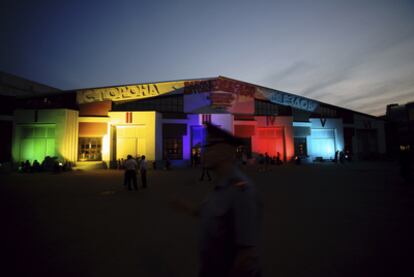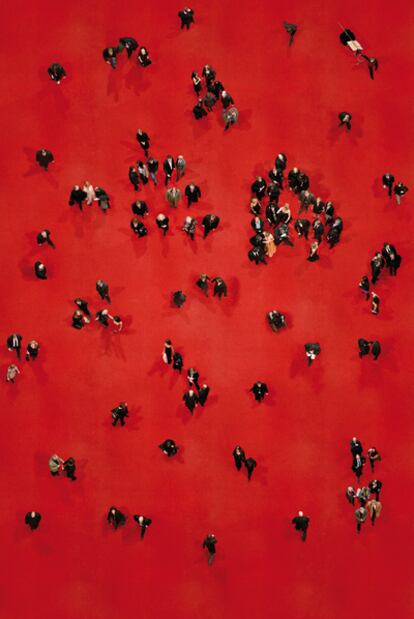Russian art, guest of honor at Arco
Old vices and new money accompany the country in its explosion onto the modern art scene
Andrei Kuzkin walked in circles for hours tethered to a pole, on a surface of fresh cement that threatened to dry around his feet. When he finally stopped, his body was bloody and his mother, alarmed, asked that he see a doctor. This happened in 2008, at a summer camp for children in the former Soviet Union, as part of the Moscow International Youth Art Biennale. Kuzkin, who won a prize for his performance, will be at Madrid's Arco fair, where Russia is this year's guest country. The artist will have a sculpture and a drawing on show at the stand of the Anna Nova gallery from Saint Petersburg. And the coordinator of the Russian delegation, Daria Pirkina, will not say whether or not Kuzkin is planning anything else.
The Russian art market is embryonic, not saturated like the markets of the West
An expert complains that Russian art is now at the service of money and power
The Russian art market is still young. Unlike the saturated markets of the West, Russia's is in an embryonic stage, its infrastructure and institutions underdeveloped. Except for Moscow and Saint Petersburg, everything is still a work in progress in the world's largest country. Yet provincial cities such as Perm, Kazan, Nizhni Novgorod and Samara are beginning to awaken from their lethargic sleep to attempt to break into the global art networks.
Pirkina has tried to provide a wide-ranging vision of Russian art today, both in terms of geography and creative style for her Arco selection, despite the context of austerity. The curator deliberately avoided showcasing institutions that focus mostly on public relations and ostentation, whether in the name of the state or of the oligarchs-turned-patrons of the arts. Instead, the Russian representation at Arco is based on galleries, foundations, institutions and forums that aim to provide a global vision of the art that has emerged in Russia since the disintegration of the USSR.
Of the eight galleries that made the final cut, five are from Moscow (Aidan, XL, Marat & Julia Guelman, GMG and Paperworks); two are from Saint Petersburg (Marina Gisich and Anna Nova) and one from Vladivostok (Arka). Together, the art on display covers two decades and two different artistic generations. Aidan and Marat & Julia Guelman were the pioneers. Aidan opened in 1992 as a reincarnation of the First Gallery founded in 1989 by Aidan Salakhova. Marat & Julia Guelman goes back to 1990 and over the years it has showcased all Russia's great contemporary artists, including Avdei and David Ter-Oganyan, Dmitri Vrubel and the controversial art group Sinie Nosi (Blue Noses). Three of the Muscovite galleries are located in Vinzavod, a former wine and spirits factory from the 19th century that has been turned into a cultural space mirroring other privately funded, industrially inspired art facilities in Europe.
Pirkina explains that Russian art in the 1990s was defined by action. Creators back then were attempting to establish the frontiers of art and determine just how far it could be developed and incorporated into society. A few major figures from that period were Anatoly Osmolovsky, Oleg Kulik and Avdei Ter-Oganyan. The latter went into exile after being threatened with a lawsuit in 1998 after his performance De-secration of Holy Objects, in which he hacked Orthodox icons to pieces.
By the first decade of the present century, there were already "frontiers, taboos and markets," the curator notes. "Unlike the last era, when there were many performances and other projects of an ephemeral nature, work now is more material and there are more attempts at creating collections. Artists in the 1990s lived from day to day and conducted experiments. These days, they are more interested in perpetuating themselves and in seeing their physical work become part of someone's collection."
Foundations such as Stella, Viktoria or Yekaterina and Vladimir Seminikhin, who possess their own collections, make up the Russian delegation's second pillar. Stella is the brainchild of Stella Kesaeva, wife of a tobacco magnate and art lover. Her lack of training in art did not stop the Culture Ministry from appointing her curator of the Russian representation at the Venice Biennale for 2011, 2012 and 2013, which some observers say is tantamount to "selling" Russia's participation in Venice. Meanwhile, Viktoria supports young artists and Yekaterina and Vladimir Seminikhin focus on conceptual art and the avant-garde movements of the Soviet era.
Russian institutions will be at Arco to provide information to the public. The Moscow Museum of Modern Art (MMOMA), the State Center for Contemporary Art (NCCA), the Perm Museum of Contemporary Art (PERMM) and Hermitage 20-21 (which manages the contemporary art collection of the Hermitage Museum) will all be there.
For Viktor Misiano, one of the differences between post-Communist art in Russia and contemporary Western art lies in commercialization. According to this seasoned specialist, art in Russia these days is at the service of capitalism, just as in earlier days it was at the service of the Socialist ideology - that is to say, there has been an inversion of roles, and the art gallery is now considered to be above the institutions.
"Art is at the service of money and power, which are now practically the same thing," he says. "During Soviet times, they were different things. In the European model, art is integrated in a system of institutions that emerge from social democracy. In Russia, the institutions are missing, and the small, provincial fairs are not designed to be meeting places or debate forums like they are in the West."
"In Europe," adds Misiano, "there is a balance between the commercial and non-commercial aspects of art. The non-commercial aspects create values, while the commercial aspects create value and price. In Russia, we are lacking that division. We have moved from Bolshevism to an authoritarian liberalism and there is no debate on the need for another model. The prevailing model is for art to be part of the state propaganda apparatus, part of public relations or at the service of the leisure needs of the economic elite."
As for the "celebrities" in today's Russian art scene, Misiano points to Olga Chernikova, whom he describes as a powerful and very refined figure. As for larger networks integrated into a transnational subculture, he mentions "Chto delat," (or, What is to be done?) a platform of artists, philosophers, literary critics and writers from Saint Petersburg, Moscow and Nizhni Novgorod.
Misiano is of the opinion that official Russian art wants to convince the West that Russia is a western country, and that it is obsessed with grandiose projects and out-of-control budgets. This is the category reserved for patrons of the arts who, "rather than award grants to young curators or nurture the local art scene, only think of how to get themselves on to the international scene. These are people who do not invest in the dynamics of culture, but in representation."
For Pirkina, the behavior patterns of art management in Russia are the same as in the West, except that Russia lacks support structures, guidance, education, grants and exhibition space. The local market also has its own peculiarities, like informal relations and a lack of contracts between galleries and artists, "although artists increasingly feel the need to formalize (these relations), since it's their money," she adds.
The creation of a national contemporary art museum is still a work in progress, despite the emergence of other museums. Misiano thinks highly of both MMOMA, whose executive director is Vasili Tsereteli, grandson of the sculptor Zurab Tsereteli, and PERMM. Both institutions were born out of a Russian setting, and continue to work in it, and in that sense they differ from initiatives like Garage, a contemporary art museum founded by Daria Zhukova, the girlfriend of oil tycoon Roman Abramovich. Garage tries to showcase Western artists and thinks in terms of public relations. But, in Misiano's view, both MMOMA and PERMM are a product of patriarchal relations and the result of personal ties between politicians and cultural celebrities - not modern, democratic, institutionalized museums. "The civilizing, cultural and innovative mission of art does not exist for our cultural bureaucracy," says Misiano.
"The task of creating a state museum of contemporary art has been on the table since 1996. Fourteen years have gone by and it hasn't been done yet and I don't know how much longer it will take," adds gallery owner Marat Guelman. "The people in charge of culture today want nothing, are able to achieve nothing and understand nothing."
Madrid's Arco International Contemporary Art Fair runs from February 16 to 21 at the IFEMA exhibition center.



Tu suscripción se está usando en otro dispositivo
¿Quieres añadir otro usuario a tu suscripción?
Si continúas leyendo en este dispositivo, no se podrá leer en el otro.
FlechaTu suscripción se está usando en otro dispositivo y solo puedes acceder a EL PAÍS desde un dispositivo a la vez.
Si quieres compartir tu cuenta, cambia tu suscripción a la modalidad Premium, así podrás añadir otro usuario. Cada uno accederá con su propia cuenta de email, lo que os permitirá personalizar vuestra experiencia en EL PAÍS.
¿Tienes una suscripción de empresa? Accede aquí para contratar más cuentas.
En el caso de no saber quién está usando tu cuenta, te recomendamos cambiar tu contraseña aquí.
Si decides continuar compartiendo tu cuenta, este mensaje se mostrará en tu dispositivo y en el de la otra persona que está usando tu cuenta de forma indefinida, afectando a tu experiencia de lectura. Puedes consultar aquí los términos y condiciones de la suscripción digital.
Últimas noticias
UN team enters Sudanese city of El Fasher after paramilitary massacre: ‘It’s like a ghost town’
A recipe for resistance: Indigenous peoples politicize their struggles from the kitchen
Grief and unanswered questions surround Swiss ski resort of Crans-Montana after fire that left 40 dead
Dead tired: The things that ruin women’s sleep
Most viewed
- Gilles Lipovetsky: ‘If you want to live better and fall in love, take Prozac, don’t look to philosophy’
- Alain Aspect, Nobel laureate in physics: ‘Einstein was so smart that he would have had to recognize quantum entanglement’
- Maduro’s downfall puts China’s relationship with Venezuela to the test
- Why oil has been at the center of Venezuela-US conflicts for decades
- Oil, gold and rare earth elements: the backdrop to US political tension with Venezuela








































